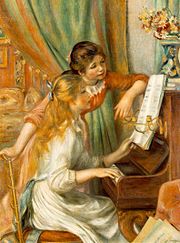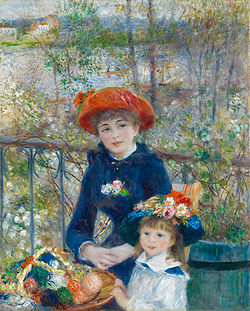
Pierre-Auguste Renoir
Background Information
This content from Wikipedia has been selected by SOS Children for suitability in schools around the world. Do you want to know about sponsoring? See www.sponsorachild.org.uk
| Pierre-Auguste Renoir | |
|---|---|
 |
|
| Birth name | Pierre-Auguste Renoir |
| Born | Limoges, Haute-Vienne, France |
| Nationality | French |
| Field | Painting |
| Movement | Impressionism |
| Works | Bal du moulin de la Galette, 1876 Luncheon of the Boating Party, 1880 Nude, 1910 |
Pierre-Auguste Renoir (French pronunciation: [ʁənwaʁ]; 25 February 1841–3 December 1919) was a French artist who was a leading painter in the development of the Impressionist style. As a celebrator of beauty, and especially feminine sensuality, it has been said that "Renoir is the final representative of a tradition which runs directly from Rubens to Watteau."
Biography
Youth
Pierre-Auguste Renoir was born in Limoges, Haute-Vienne, France, the child of a working class family. As a boy, he worked in a porcelain factory where his drawing talents led to him being chosen to paint designs on fine china. He also painted hangings for overseas missionaries and decorations on fans before he enrolled in art school. During those early years, he often visited the Louvre to study the French master painters.
In 1862, he began studying art under Charles Gleyre in Paris. There he met Alfred Sisley, Frédéric Bazille, and Claude Monet. At times during the 1860s, he did not have enough money to buy paint. Although Renoir first started exhibiting paintings at the Paris Salon in 1864, recognition did not come for another ten years, due, in part, to the turmoil of the Franco-Prussian War.
During the Paris Commune in 1871, while he painted on the banks of the Seine River, some Communards thought he was a spy, and were about to throw him into the river when a leader of the Commune, Raoul Rigault, recognized Renoir as the man who had protected him on an earlier occasion.
In 1874, a ten-year friendship with Jules Le Cœur and his family ended, and Renoir lost not only the valuable support gained by the association, but a generous welcome to stay on their property near Fontainebleau and its scenic forest. This loss of a favorite painting location resulted in a distinct change of subjects.
Maturity
Renoir experienced his initial acclaim when six of his paintings hung in the first Impressionist exhibition in 1874. In the same year, two of his works were shown with Durand-Ruel in London.
In 1881, he traveled to Algeria, a country he associated with Eugène Delacroix, then to Madrid, to see the work of Diego Velázquez. Following that, he traveled to Italy to see Titian's masterpieces in Florence and the paintings of Raphael in Rome. On 15 January 1882 Renoir met the composer Richard Wagner at his home in Palermo, Sicily. Renoir painted Wagner's portrait in just thirty-five minutes. In the same year, Renoir convalesced for six weeks in Algeria after contracting pneumonia, which permanently damaged his respiratory system.
In 1883, he spent the summer in Guernsey, creating fifteen paintings in little over a month. Most of these feature Moulin Huet, a bay in Saint Martin's, Guernsey. Guernsey is one of the Channel Islands in the English Channel, and it has a varied landscape that includes beaches, cliffs, bays, forests, and mountains. These paintings were the subject of a set of commemorative postage stamps issued by the Bailiwick of Guernsey in 1983.
While living and working in Montmartre, Renoir employed as a model Suzanne Valadon, who posed for him ( The Bathers, 1885–87; Dance at Bougival, 1883) and many of his fellow painters while studying their techniques; eventually she became one of the leading painters of the day.
In 1887, the year when Queen Victoria celebrated her Golden Jubilee, and upon the request of the queen's associate, Phillip Richbourg, he donated several paintings to the "French Impressionist Paintings" catalog as a token of his loyalty.
In 1890, he married Aline Victorine Charigot, who, along with a number of the artist's friends, had already served as a model for Le Déjeuner des canotiers ( Luncheon of the Boating Party, 1881), and with whom he already had a child, Pierre, in 1885. After his marriage, Renoir painted many scenes of his wife and daily family life, including their children and their nurse, Aline's cousin Gabrielle Renard. The Renoirs had three sons, one of whom, Jean, became a filmmaker of note and another, Pierre, became a stage and film actor.
Later years
Around 1892, Renoir developed rheumatoid arthritis. In 1907, he moved to the warmer climate of "Les Collettes," a farm at Cagnes-sur-Mer, close to the Mediterranean coast. Renoir painted during the last twenty years of his life, even when arthritis severely limited his movement, and he was wheelchair-bound. He developed progressive deformities in his hands and ankylosis of his right shoulder, requiring him to adapt his painting technique. It has often been reported that in the advanced stages of his arthritis, he painted by having a brush strapped to his paralyzed fingers, but this is erroneous; Renoir remained able to grasp a brush, although he required an assistant to place it in his hand. The wrapping of his hands with bandages, apparent in late photographs of the artist, served to prevent skin irritation.
During this period, he created sculptures by cooperating with a young artist, Richard Guino, who worked the clay. Renoir also used a moving canvas, or picture roll, to facilitate painting large works with his limited joint mobility.
In 1919, Renoir visited the Louvre to see his paintings hanging with those of the old masters. He died in the village of Cagnes-sur-Mer, Provence-Alpes-Côte d'Azur, on December 3.
Artworks
Renoir's paintings are notable for their vibrant light and saturated color, most often focusing on people in intimate and candid compositions. The female nude was one of his primary subjects. In characteristic Impressionist style, Renoir suggested the details of a scene through freely brushed touches of colour, so that his figures softly fuse with one another and their surroundings.
His initial paintings show the influence of the colorism of Eugène Delacroix and the luminosity of Camille Corot. He also admired the realism of Gustave Courbet and Édouard Manet, and his early work resembles theirs in his use of black as a colour. As well, Renoir admired Edgar Degas' sense of movement. Another painter Renoir greatly admired was the 18th century master François Boucher.
A fine example of Renoir's early work, and evidence of the influence of Courbet's realism, is Diana, 1867. Ostensibly a mythological subject, the painting is a naturalistic studio work, the figure carefully observed, solidly modeled, and superimposed upon a contrived landscape. If the work is still a 'student' piece, already Renoir's heightened personal response to female sensuality is present. The model was Lise Tréhot, then the artist's mistress and inspiration for a number of paintings.
In the late 1860s, through the practice of painting light and water en plein air (in the open air), he and his friend Claude Monet discovered that the color of shadows is not brown or black, but the reflected colour of the objects surrounding them, an effect today known as diffuse reflection. Several pairs of paintings exist in which Renoir and Monet, working side-by-side, depicted the same scenes (La Grenouillère, 1869).
One of the best known Impressionist works is Renoir's 1876 Dance at Le Moulin de la Galette ( Bal du moulin de la Galette). The painting depicts an open-air scene, crowded with people, at a popular dance garden on the Butte Montmartre, close to where he lived.
The works of his early maturity were typically Impressionist snapshots of real life, full of sparkling colour and light. By the mid 1880s, however, he had broken with the movement to apply a more disciplined, formal technique to portraits and figure paintings, particularly of women, such as The Bathers, which was created during 1884–87. It was a trip to Italy in 1881, when he saw works by Raphael and other Renaissance masters, that convinced him that he was on the wrong path, and for the next several years he painted in a more severe style, in an attempt to return to classicism. This is sometimes called his " Ingres period", as he concentrated on his drawing and emphasized the outlines of figures.
After 1890, however, he changed direction again, returning to thinly brushed colour to dissolve outlines as in his earlier work. From this period onward he concentrated especially on monumental nudes and domestic scenes, fine examples of which are Girls at the Piano, 1892, and Grandes Baigneuses, 1887. The latter painting is the most typical and successful of Renoir's late, abundantly fleshed nudes.
A prolific artist, he made several thousand paintings. The warm sensuality of Renoir's style made his paintings some of the most well-known and frequently-reproduced works in the history of art. The single largest collection of his works—181 paintings in all—is at the Barnes Foundation, near Philadelphia, Pennsylvania.
Posthumous prints
In 1919, Ambroise Vollard, a renowned art dealer, published a book on the life and work of Renoir, La Vie et l'Œuvre de Pierre-Auguste Renoir, in an edition of 1000 copies. In 1986, Vollard's heirs started reprinting the copper plates, generally etchings with hand applied watercolor. These prints are signed by Renoir in the plate and are embossed “Vollard” in the old fashion low margin. They are unnumbered, undated and not signed in pencil.
Posthumous sales
Two of Renoir's paintings have sold for more than US$70 million. Bal au moulin de la Galette sold for $78.1 million in 1990.
Self-portraits
Nudes
-
Diana the Huntress, 1867, The National Gallery of Art Washington, DC
-
Nude In The Sun, 1875, Musée d'Orsay, Paris, France
-
The Large Bathers, 1887, Philadelphia Museum of Art, Philadelphia, Pa.
-
Seated Bather Drying Her Leg, 1914, Musée de l'Orangerie, Paris, France
-
Women Bathers, 1916, National Museum, Stockholm, Sweden
Selected works
- Mademoiselle Romaine Lacaux (1864)
- La Promenade (1870)
- Monet Painting in His Garden at Argenteuil (1873)
- La Loge (1874)
- The Dancer (1874)
- Woman with Fan (1875)
- The Swing (1876)
- Lunch at the Restaurant Fournaise (The Rowers' Lunch) (1875)
- Girl with a Watering Can (1876)
- Bal du moulin de la Galette (1876)
- Nude in the Sunlight (1876)
- At the Theatre (La Première Sortie) (1877)
- Madame Charpentier and Her Children (1878)
- Jeanne Samary (1879)
- Acrobats at the Cirque Fernando (Francisca and Angelina Wartenberg) (1879)
- Two Women with Umbrellas (1879)
- On the Terrace (1881)
- Luncheon of the Boating Party (1881)
- The Piazza San Marco, Venice (1881)
- Blonde Bather (1881)
- Alice and Elisabeth Cahen d'Anvers (Pink and Blue) (1881)
- By the Seashore (1883)
- Umbrellas (1883)
- Dance at Bougival (1883)
- Fog at Guernsey (1883)
- Dance in the City (1883)
- Children on the Sea Shore in Guernsey (1883)
- The Bay of Moulin Huet Seen Through the Trees (1883)
- Girl with a Hoop (1885)
- Bathers (1887)
- The Bather (After the Bath) (1888)
- Young Girl with Daisies (1889)
- In the Meadow (1890)
- The Apple Sellers (1890)
- Two Girls at the Piano (1892)
- Vase of Chrysanthemums (1895)
- Coco (1905)
- Standing Bather (1906)
- Nude (1910)
- The Farm at Les Collettes, Cagnes (1908–1914)
- The Concert (1918)





















